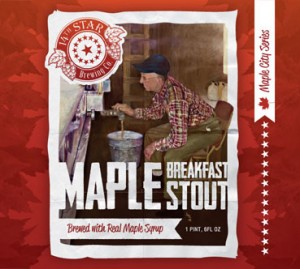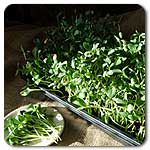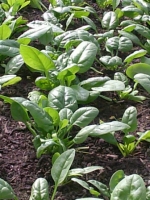The classic backyard food party is the summer BBQ. Folks have their grills, some have campfires, some have barbecue pits, one friend of mine added a backyard smoker for making smoked onion rings (really, what’s a summer party without smoked onion rings?). And I enjoy those events. In fact, I support eating every meal of summer outside. But the essential cooking equipment that I want in my backyard isn’t a grill for BBQs – it’s a table for hosting sugar on snow parties in the spring.
Sugar on snow involves heating maple syrup until it just reaches the softball stage (about 234 degrees Fahrenheit), taking it off the heat for a few moments, then drizzling it over snow so that it turns into a sort of maple taffy you can eat with a fork. It’s usually served with a pickle and plain doughnut. In my memory there is a glass of milk, however I don’t think that’s traditional – it ought to be.
You don’t technically need a sugar on snow table. You could just pour hot syrup straight onto a clean patch of snow. Or put snow in bowls and eat it that way. But a communal table where everyone grabs a fork and goes at it in a syrup free for all makes for a much better party in my book.
You know what would make this snow taste better? Maple Syrup
Neighbors of mine when I lived in East Montpelier, Paul and Sandal, threw a sugar on snow version of a block party in the spring. Theirs was the best set up I’ve seen, so I wrote to Sandal to get details on its construction. Turns out, they don’t just have a table for party purposes, they have an entire sugar on snow strategy that can be modified by year. Sandal replied:
“We use an old cream separating pan which we pack with late season snow (and are always glad to have some on hand on our farm which tilts enough to the north to keep it around). The pan has a drain in it which is fine and handy as the snow melts but not critical because with the kids (little and big) who show up the sugar disappears before the snow melts to any degree! When I don’t need to use the big pan, or if I want to ‘save the snow’ (seriously!), I pack it into food grade oblong tubs and put it in the freezer. Those work great, too. One or more times when we had had a lot of snow over the winter, we’d just pack it alongside a path and folks could stand there and eat it right off the leveled bank!”
I really wish I’d been there for the snowbank-at-table-height years.
I wrote to the manager of the Capital City Farmers’ Market to see if she had pictures of the tables used at their annual Sugar on Snow party (happening this weekend, March 29th, 10:00 am – 1:00pm at the Vermont College of Fine Arts in Montpelier). According to the photographs, sugar makers there last year built long troughs to set on top of folding tables.
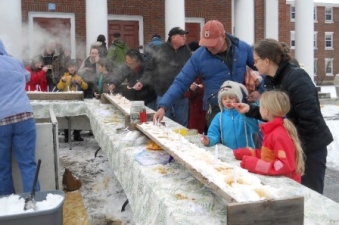
Capital City Winter Farmers Market, Montpelier VT; Photo by Carolyn Grodinsky
At large events, I often see the sort of cardboard containers hot dogs come in at the fair pre-packed with shaved ice and stacked in a freezer for serving sugar on snow – presumably no backyard party will get large enough to require that time saving strategy.
Canada has a whole different set up at their sugar houses, including special syrup pourers that make parallel lines of syrup along the top of the snow.
I’ve never seen it attempted, but presumably one could also repurpose a foosball or air hockey table into a sugar on snow option . . .
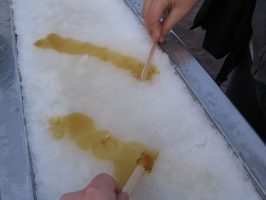
I realize that gathering friends for food in the backyard is not as appealing in the gray, soggy, cold days of late March and early April compared to a sunny afternoon in July. I would argue, however, that we need it more now than in the summer, when we take being outside for granted. If folks put some creative effort into having the best sugar on snow equipment among their neighbors, then there’d be double the incentive for calling a party (as if the opportunity to eat forkfuls of pure maple syrup until you can’t take any more weren’t incentive enough). So this year I’m on the lookout for design inspiration and next year I just might throw the best sugar on snow parties for miles around. And after that, who knows? Maybe I won’t only build the maple syrup eating contraptions, but some maple syrup making ones as well.
Helen Labun Jordan writes about food, agriculture, and other topics too from her home in Montpelier, VT.
Source: Dig in VT Trails


